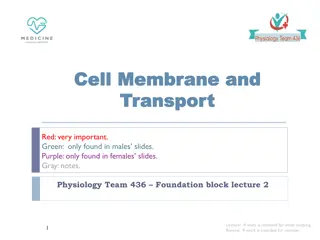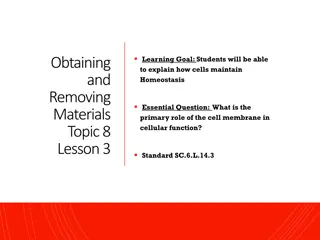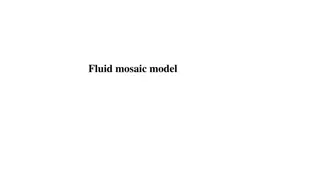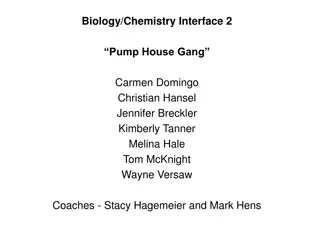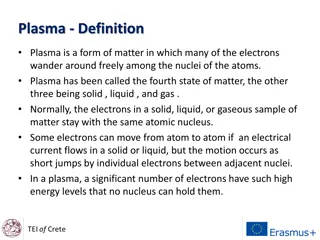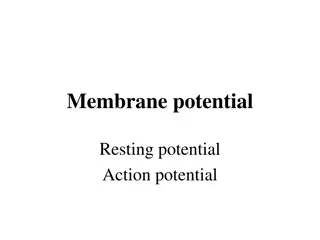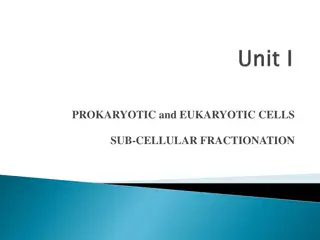Understanding the Composition and Function of the Plasma Membrane in Animal Cells
The plasma membrane is a vital component of animal cells, serving as a barrier that regulates the passage of substances. Composed mainly of lipids and proteins, it plays a crucial role in cell structure and function. This article explores the chemical composition, molecular structure, and significance of the plasma membrane in cellular biology.
Download Presentation

Please find below an Image/Link to download the presentation.
The content on the website is provided AS IS for your information and personal use only. It may not be sold, licensed, or shared on other websites without obtaining consent from the author. Download presentation by click this link. If you encounter any issues during the download, it is possible that the publisher has removed the file from their server.
E N D
Presentation Transcript
PLASMAMEMBRANE INTRODUCTION All the animal cells are delimited by a thin elastic selectively permeable living membrane. It separates the cytoplasm from the surrounding environment. It is an integral part of the cell. It is named as cell membrane by C.CRAMER and C.NAGELI in 1885. J.Q.PLOWE named it as PLASMA LEMMA in 1931. To avoid confusion with respect to cell wall of plant cell De ROBERTIS and other modern cytologists called it as PLASMA MEMBRANE which became popular now.
DEFINITION Plasma membrane can be defined as a thin elastic double unit membrane made of lipoprotiens which separates cell from the extra cellular medium and regulates the passage of various substances such as solvents, solute particles, water across it. Plasma membrane can be easily separated from the cytoplasm only in certain cells such as mammalian erythrocytes and nerve cells. The thickness of plasma membrane varies in different types of cells which varies between 75-105 Angstrom units. Under electron microscope the plasma membrane appears to be made of three layers. 1) a dense outer layer- 20 Angstroms 2) a dense inner layer- 20 Angstroms 3) a middle layer between the two dense layers 35Angstroms Of these three layers the outer and inner layers are said to be formed of protein molecules and the middle one is made of two layers of phospholipids.
CHEMICAL COMPOSITION Plasma membrane is made up of lipids, proteins, a fraction of oilgo saccharides and water. But the main constituents are lipids and proteins, hence the plasma membrane is said to be a lioproteinous membrane. LIPIDS: Plasma membrane contains 20-79 % of lipids. They are mainly present as phospholipids and cholesterol. The phospholipids are of two types: oNeutral phospholipids: These lipids have no electrical charge. They are tightly packed as a bilayer in the plasma membrane. o Acid phospholipids: These are negatively charged and are associated with proteins forming lipoproteins.
PROTEINS: Proteins form the main components of the plasma membrane, but their amount varies from one cell to the others. Two types of proteins viz. Structural proteins and functional proteins are present in plasma membrane. o STRUCTURAL PROTEINS: They are concerned with mechanical structure of the membrane. They form the backbone of the plasma membrane. They are of two types: a) Intrinsic or Internal proteins: They are present embedded between the molecules of phospholipids and form an integral part of the membrane. b) Extrinsic or peripheral proteins: They are loosely arranged on the surface of the membrane and can easily be separated. o FUNCTIONAL PROTEINS: They carryout several functions. Some of them act as carriers in the transport of substances. Some of them are present as enzymes. OLIGOSACCHARIDES: In 1962 BELL suggested that plasma membrane is also composed of a fraction of oligosaccharides like hexose, sialic acid and fucose. These oligosaccharides remain bounded to proteins.
MOLECULAR STRUCTURE OF PLASMA MEMBRANE There is no direct technique to study the structure of the plasma membrane. All the information available is only through indirect techniques only. Many theories are proposed to explain the molecular structure of plasma membrane. 1. Bi molecular leaf-let model Danielli and Davson 2. The tri-laminar model or Greater membrane model or Unit membrane theory Robertson 3. Micellar model Hilleir and Hoffman 4. Fluid Mosaic Model S.J. Singer and G.L. Nicolson
DIFFERENT MODELS OF THE STRUCTURE OF PLASMA MEMBRANE
1.Bi-molecularleaf let model: J.D. Danielli and Hugo Davson proposed this model of plasma membrane in 1934. According to this theory, plasma membrane consists of a double layer of phospholipid molecules (bilayer) sand-wiched between two layers of protein molecules.
2. Unit membrane theory: This model was proposed by J.David Robertson. He noticed that the plasma membrane of prokaryotes and eukaryotes under elecgtron microscope appear as a three layered structure (trilaminar) with 75-100 angstroms thickness. Robertson called this as a unit membrane.
3. Micellar model: Hilleir and Hoffman (1953) suggested that the plasma membrane has a non-lamellar arrangement. It contains globular subunits of phospholipids in its interior. Each subunit is called micelle. These micelles form the building blocks of the membrane.
4.Fluid Mosaic model: This model was proposed by S.J.Singer and G.L.Nicolson in 1972. This model is also known as Lipid Globular protein Mosaic model. In this theory it is stated that the phospholipid molecules relinked to a sea in which are present protein molecules floating like ice-bergs. The phospholipid molecules are arranged as a bilayer with their hydrophillic polar heads towards periphery and hydrophobic nonpolar ends turned inwards.
SPECIALITY STRUCTURES OR MODIFICATIONS OF PLASMA MEMBRANE The plasma membranes of certain cells possess additional structures that are concerned with functions like protection, absorption, secretion, transport etc. a) Cell coat or Glycocalyx: This is defined as a thinfilm present on the surface of almost all cell membranes. The cell wall of plant cell and pellicle of protozoans are the best examples. It is formed of mucopolysaccharides or oligosaccharides . b) Microvilli: Microvilli are ultra microscopic finger like projections formed by the evaginations of plasma membrane. They are present in the cells of intestinal epithelium. Each cell may possess about 3000 microvilli. Each microvillus is about 0.6 to 0.8 micron long and 0.1 micron in diameter.
c) Junctional complexes: Generally the plasma membrane of adjacent cells remain separated by the intercellular space. However some cells are placed too close to each other and some are too far. Under such circumstances the membrane proteins of adjacent cells interact with each other in a specific way to form an intercellular junction. These junctions may be in the form of Macule, Zonule, Occludens, Adhaerens. d) Various junctional complexes: Zonaloccludens(Tightjunctions): The outer unit membranes of plasma membrane of adjacent cells come in contact without any intercellular space. Spot desmonemes (Macula adherens or Binding bodies): In some epithelial cells the plasma membrane of adjacent cells are separated by an intercellular space of 300 to 50 angstroms. The inner unit membrane of each adjacent cell at this region possesses a circular thickening that projects into cytoplasm which are like discs called as desmonemes. Many fine filaments called tonofibrils radiate from there discs into cytoplasm of the cell. Zonula adherens(Terminal base or Intermediary junction): These are similar to desmonemes but they donot have tonofibrils.
Gap junctions(Nexus or Macula occludens): These are described as submicrosopic gaps between the cell membranes of adjacent cells. Inter digitations: These are finger like projections formed from the plasma membranes of two adjacent cells. Pores of plasma membrane: Plasma membrane is perforated by pores which can be seen only under electron microscope. These pores help in passive diffusion of Na, K and Ca ions and molecules (water, CO2 and O2).
FUNCTIONS OF PLASMA MEMBRANE The plasma membrane provides stability to the cell and maintain its shape. The main functions of plasma membrane is to regulate flow of ions and molecules of various substances into and out of the cell . Different methods of transport are: 1) Osmosis: Passage of water and other solvnets through a semipermeable membrane from lower concentration to higher concentration. 2) Diffusion: The transport of ions and molecules of various substances from regions of higher concentration to higher concentration. It is described as downhill movement and passive transport because it does not require ATP. 3) Facilitated diffusion: It is a kind of transport in which substances diffuse from a region of higher concentration to a region of lower concentration with the help of certain substances called carriers. So this is also passive transport. 4) Active transport: The transport of substances across the membrane against the concentration and electrochemical gradients. The molecules or ions move from the region of lower concentration to the region of higher concentration.
Endocytosis: It is a kind of transport of substances in which the plasma membrane engulfs foreign objects and transport them by forming vescicles around them . Depending on the nature of food or foreign substances the endocytosis is differentiated into two types. a) Picnocytosis: Intake of fluid materials which are unable to pass through the cell membrane. It was first observed by Edward in Amoeba. b)Phagocytosis: The process of engulfing large sized solid objects by the plasma membrane. 5) Exocytosis (Cell vomiting or Emeiocytosis): This is a reverse process of endocytosis. The several substances secreted by the glands are released by the plasma membrane to the extra cellular medium. 6) Cytopemphis: If a substance passes into the cell by means of endocytosis and leaves the cell by exocytosis without undergoing any change. _______THE END_______




